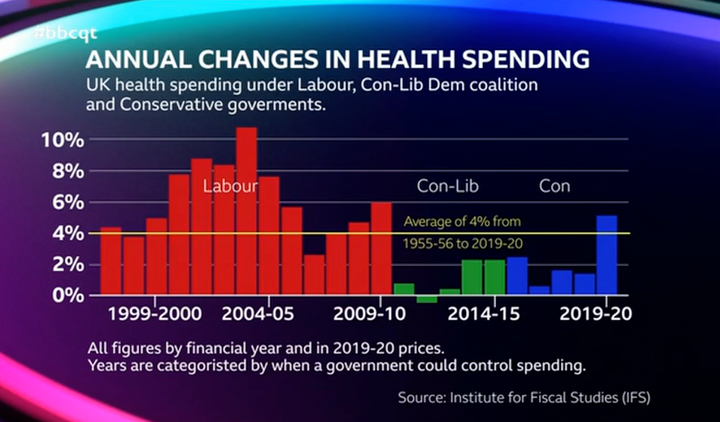BBC Question Time presenter Fiona Bruce has said a Conservative claim of record spending on the NHS “doesn’t look so good” after a minister was confronted with a damning graph.
A special edition of the corporation’s flagship political programme from Hoddeson, Hertfordshire, was devoted to health as the sector faces multiple crises, most notably a stand-off with nurses and other staff over pay.
Bruce presented health minister Will Quince with a graphic using Institute of Fiscal Studies data suggesting NHS spending between 1955-56 and 2019-20 increased by an average of 4% – but the annual rise has been below that for all but one year since 2010.

Bruce said: “Let’s just look at a graph looking at funding of the NHS. This will be familiar to you, in terms of where funding was for the NHS before the Conservative government came into power and where it is now.
“As you can see, if you look at the average there, it’s pretty dramatic in terms of the drop in funding. So when you talk about record investment, that doesn’t look so good.”
Quince replied by not addressing the point of the graph – that health spending went up by a greater percentage in the Labour years – but by saying “we’re spending more on health and social care now than ever in our country’s history”.
Bruce followed up by saying “the average increase has been something like 3% but when you look at that, it’s more like 1.6%”.
But Quince persisted: “If you take, for example, 2010, it was around £100bn that we spent on the NHS. By 2025, it will be £166bn.
“And, if you look at when times were tough, for example, when we came out of the economic crisis in 2008-2009, the coalition government, despite having to make reductions in spending elsewhere, prioritised the NHS.”
It’s unclear precisely which research by the respected think-tank the graph refers to. But one study that does not include the latest annual figure states spending increased by 6% annually during the Blair-Brown years, dropped to 1% under the coalition, and was up to 1.6% under the Conservative government up to 2018-19.
In any case, many watching seized on the figures.
The IFS report said: “UK health spending increased in real terms by an annual average of 3.6% per year between 1949-50 and 2018-19.
“Spending increased sharply during the late 1990s and 2000s, growing by an average of 6% per year during the Blair and Brown governments as part of a wider growth in public service spending.
“Since 2009-10, health spending growth has slowed sharply. Between 2009-10 and 2018-19, real spending grew by an annual average of 1.3%. Average increases of 1% per year under the coalition government (2009-10 to 2014-15) were the smallest five-year average seen under any government.
“However, it is important to note that these increases took place over a period during which most areas of public spending experienced large reductions. Indeed, spending on areas such as education, defence, and public order and safety has fallen, while spending on health has continued to rise – albeit at a slower rate than has tended to be the case historically.”

